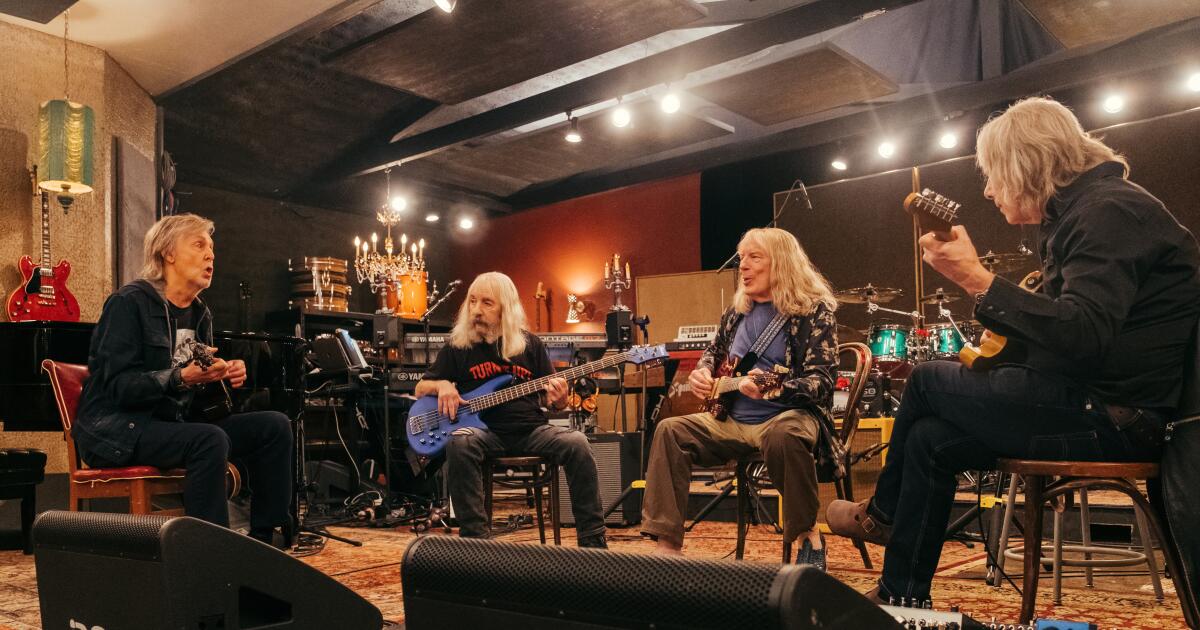‘Spinal Tap II: The End Continues’ review: Power cameos sap the satire
The cultural legacy of the 1984 rock-mock-doc “This Is Spinal Tap” is of sufficient amplitude that, to give the band’s guitarist Nigel Tufnel (Christopher Guest) his knob-twiddling due, it’s gone way past 11.
Perennially quotable, ad-libbed to Brit-accented perfection by co-creators Guest, Michael McKean and Harry Shearer and finessed into an iconic spoof by director Rob Reiner, “Spinal Tap” was born. The movie both ridiculed (and, slyly, furthered the cause for) the metal world’s idiotic excesses, but also an industry’s love of a satisfying comeback saga.
When your fake movie becomes gospel truth to admiring music legends and a pretend forgotten band goes on to play Wembley in real life, the fine line between clever and stupid (again, so quotable) suddenly looks like a rarefied space for a sequel to exploit.
Yet when the key comic minds behind that singular sendup of past-prime glory-seekers aim to rekindle their magic, “Spinal Tap II: The End Continues” leaves one thinking some classics are better left in their original, endlessly re-playable states.
Not that the sight, 40 years on, of the sweetly clueless Tufnel, McKean’s prickly frontman David St. Hubbins and Shearer’s man-of-few-blurts Derek Smalls reuniting for one last concert won’t trigger a low-wattage 83-minute-long smile. But the concept of Tap being revered (by legend cameos Paul McCartney and Elton John, no less) saps the comedy of outsider tension, making for something closer to a feature-length outtake reel than a fresh take on clownish notoriety.
There’s agreeable silliness early on in seeing where the trio has landed in their solo lives, from acknowledged retail dreamer Nigel’s cheese-and-guitar shop to the fringes of the recording world, where California-transplanted David finds himself composing phone-hold music. In these moments, you get a glimpse of the special sauce of personality delusion that Guest, as a director, turned into a mini-genre (“Waiting for Guffman,” “Best in Show,” “A Mighty Wind”). But when dead Tap manager Ian Faith’s daughter, Hope (Kerry Godliman), having inherited daddy’s contract, forces the members to gather in New Orleans for an arena show, the whole thing loses an essential oddball energy, trying to coast on a masterpiece’s fumes.
Gag encores are pitfalls. The famous drummer mortality problem is a case in point, wearing out its understandable reviving with star cameos (Questlove, Lars Ulrich) and a lackluster tryout montage. Then, after the hiring of an energetic young replacement (Valerie Franco), a humor opportunity is missed when we wonder why she isn’t pushing back on having to play songs like “Bitch School.” Even the band’s second chance at a Stonehenge showstopper is more like a joke in name only.
The three leads can still, when given room, generate an anything-can-happen vibe, even if the improvisatory pearls are in short supply. But there are quite a few instances when the promise of comedic friction is undercooked or ignored and the new strains of hinted lunacy (as when Guest regulars John Michael Higgins and Don Lake show up) never quite soar.
The funniest addition, because it feels genuinely pointed about the milieu, is Chris Addison as the band’s aggressive promoter Simon, who prides himself on being impervious to enjoying music, and tells our septuagenarian rockers that for posterity’s sake, ideally, two of them should die during the show. Thankfully, nothing in “Spinal Tap II” will kill off the original’s legacy. It’s just a nostalgia lap you wish had more 11.
‘Spinal Tap II: The End Continues’
Rated: R, for language including some sexual references
Running time: 1 hour, 23 minutes
Playing: In wide release Friday, Sept. 12

